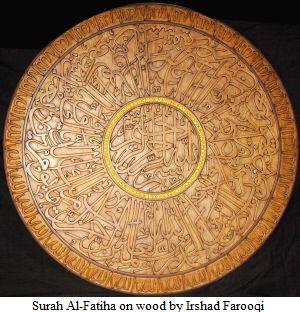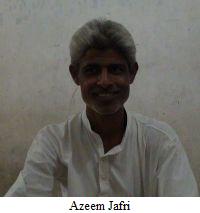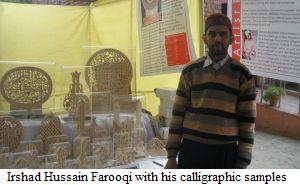 THE art of Islamic calligraphy finds its roots in early Islam. Part of its popularity lay in the way Quran stresses the importance of written word. In Surah 96 (verse 3 to 4), God is described as one Who “taught man with the pen”. The Surah 68 starts with the oath, “And by the Pen”. There are several other Suras talking about writing, viz., Surah 96 (verse 3 to 4), Surah 82 (verse 10), Surah 50 (verse 16). Naturally, the best style of writings were developed for God. As Arabic became the language of all Muslims in Arabia and elsewhere, it gave birth to beautiful new forms of Arabic script.
THE art of Islamic calligraphy finds its roots in early Islam. Part of its popularity lay in the way Quran stresses the importance of written word. In Surah 96 (verse 3 to 4), God is described as one Who “taught man with the pen”. The Surah 68 starts with the oath, “And by the Pen”. There are several other Suras talking about writing, viz., Surah 96 (verse 3 to 4), Surah 82 (verse 10), Surah 50 (verse 16). Naturally, the best style of writings were developed for God. As Arabic became the language of all Muslims in Arabia and elsewhere, it gave birth to beautiful new forms of Arabic script.

Prophet Muhammad’s son-in-law and the fourth Caliph of Islam, Ali ibn Abi Talib is considered to be the first master of calligraphy. He developed a Kufic script where the tops of alifs were twin-horned. [1] The Kufic in general is an angular script found on tombstones and coins.
The sacred nature of calligraphy ensured that in Islamic architecture inscriptions became an important means of decoration. Beautiful Islamic inscriptions soon adorned mosques, madrasas, mausoleums, and shia imambaras. The art was gradually extended to other secular texts.
Calligraphy in India flourished during the Mughals and later on found patronage with the Nawabs of Awadh. The evidence of the earliest Arabic inscriptions on structures of 8th century have been found in India at Deybal (Sind), which is now in Pakistan. [2]
 Unfortunately Islamic calligraphy is a dying art in India with very few people left practising it full time. Traditional calligraphy is the worse hit. Laments Saiyed Anwer Abbas, a Lucknow based historian, “The present state of calligraphy is not healthy for traditional calligraphy (by pen) since the advent of calligraphy and inscription by computer. There is some scope in ‘Tughra-nawisi’ because the calligrapher presents new designs (Tughra) according to his own ideas and imagination. Now, with knowledge of Urdu script becoming scarce in India, even the scope of tughra-nawisi is not bright.”
Unfortunately Islamic calligraphy is a dying art in India with very few people left practising it full time. Traditional calligraphy is the worse hit. Laments Saiyed Anwer Abbas, a Lucknow based historian, “The present state of calligraphy is not healthy for traditional calligraphy (by pen) since the advent of calligraphy and inscription by computer. There is some scope in ‘Tughra-nawisi’ because the calligrapher presents new designs (Tughra) according to his own ideas and imagination. Now, with knowledge of Urdu script becoming scarce in India, even the scope of tughra-nawisi is not bright.”
Abbas is not alone, renowned Lucknow based calligraphy artist Hashim Akhtar Naqvi (credited with inscribing ‘Bismillah-ir-Rehman-ir-Raheem’ in over 6,000 calligraphic designs ), echoes similar sentiments, “It is true that my exhibitions of Bismillah-ir-Rehman-ir-Raheem draw huge crowds at all venues in India, but till date not even a single person approached me to learn calligraphy.” He feels the government is also not very keen to revive the art and he is not willing ‘to go out of the way to seek government assistance.’
Ghalib Academy (Hazrat Nizammudin), New Delhi, too has stopped its two year programme in Urdu Calligraphy.
 MT had a first hand experience of this rare art at the house in Lucknow of another calligrapher, Azeem Jafri. A painter by profession, Jafri, mixes calligraphy skills with his work. He’s very passionate about the art and feels it’s a pious and ‘halal’ way to earn money. Jafri is training both his children (a son and a daughter) to carry on his legacy. He told MT that people don’t value his creations on paper. “Some people give me Rs 500 for a sample, few art lovers from outside even pay Rs 5000, but most think it’s all worth only Rs 300,” says Jafri with a touch of sadness.
MT had a first hand experience of this rare art at the house in Lucknow of another calligrapher, Azeem Jafri. A painter by profession, Jafri, mixes calligraphy skills with his work. He’s very passionate about the art and feels it’s a pious and ‘halal’ way to earn money. Jafri is training both his children (a son and a daughter) to carry on his legacy. He told MT that people don’t value his creations on paper. “Some people give me Rs 500 for a sample, few art lovers from outside even pay Rs 5000, but most think it’s all worth only Rs 300,” says Jafri with a touch of sadness.
Irshad Hussain Farooqi is a rare craftsman who practices calligraphy on wood. In general Calligraphy is two dimensional, however, with efforts of people like Farooqi, producing it on wood makes it three dimensional. He plans to set up an institute of calligraphy in India. He’s currently rebuilding his workshop in Delhi which he plans to use for imparting calligraphic lessons also. He is keen to take his designs to the Dubai International Exhibition for Arabic Calligraphy but needs help on that front. “I want to do much more for calligraphy in India but so far I’m unable to reach the right people,” informs Farooqi.
The Musalman is one of a kind (evening) newspaper. It is handwritten by calligraphers before being mass produced. The paper was founded in 1927 by Syed Azmathullah. It’s office is located at the Triplicane High Road in Chennai. Despite all obstacles the newspaper has managed to survive this long. MT contacted their office for more insight but was politely declined, “We don’t give interviews to anybody.” We don’t mind till this unique tradition continues.
Notes
1 Prof. Annemarie Schimmel, Islamic Calligraphy (Institute of Religious Iconography, State University Groningen, Leiden E. J. Brill, 1970, Netherlands), 3.
2 Saiyed Anwer Abbas, Lucknow Ki Lupt Hoti Kalayen, Hamara Lucknow Pustakmala Series (Hindi Vangmaya Nidhi, 2012)

Really nice article on the state of affairs as far as Islamic calligraphy is concerned.
It was indeed heart warming to read about Tughra-nawisi, for which my peersahab and ustad Amir Abdullah Khan Khan was so well known.
I suppose all those interested should get together in whatever capacity to work seriously towards this aim. i, in my own very tiny way have started an organisation Qalamkaari Creative Calligraphy Trust in Delhi, primarily to keep the magnificent art alive. In fact Irshad Farooqui Sahab was one of the participants. I must say the response was very positive, given the fact that most people who came did not come for a religious reason. they came to see ART and that is what we must work at.
Calligraphy both in its traditional as well as modern contemporary avatar needs to be revived and encouraged. Unless people get to see the immense beauty and khazana lying in this art, how can we expect a change or revival ? we will continue to complain and crib.
I am happy that at least people are talking about calligraphy as an important art form. I do believe that this art has to be seen as a full fledged, important visual art form only then will people see it outside the confines of one particular religion. Art forms do have the power to transcend boundaries. Apni soch aur kaavish, dono ko wasi karna hoga !! mujhe yaqeen hai ki Calligraphy has a bright future!
Qamar Dagar
i ws happy 2 join in islm cmity
I am in love with Allah .I want to write name of Allah and word of Aallh beautifully ………but I know where to go in delhi to learn arabic and urdu caligraphy.
Saba you could contact Irshad Hussain Farooqi sahab in Zakir Nagar or Aseem Asha who drives the Flying Birds initiative in Okhla.
Marvellous! I really loved it…I also want to learn arabic calligraphy
Asalaamu ‘alaikum
Where can I learn Arabic Calligraphy in Mumbai? Please help
I’ll check and revert.
Even I am very passionate about learning islamic calligraphy. I am a resident of mumbai and do not know where to go. Plz plz plz help.
I’ll check and revert.
Assalamualikum …sir koi agar arabic calligraphy artist ho jo aligarh mai kaam karwa de to plzzz contact its urgent …my no is 8899427718 A.M.U mai kaam hona hai …plzz
Please mail me the details of the work at inam.abidi@gmail.com, in case it’s still pending.
We wantQuran Shareef in Arabic language in CDR file.
If you are based in Delhi, may be a visit to Nizamuddin or Old Delhi could come handy. Please also try Amazon or Flipkart.
Hi , My name is ambika sukumar … I am business of Promoting art specifically rare art … In India , Islamic calligraphy is now rarest to rarest … We have start up company based in India , Delhi which is backed by VC based in Paris .. We are looking for some details or known / unknown artist / institutions which are still in process of saving this art form … If You could help us … Please mail me ambikasukumar@gmail.com
Please check your email.